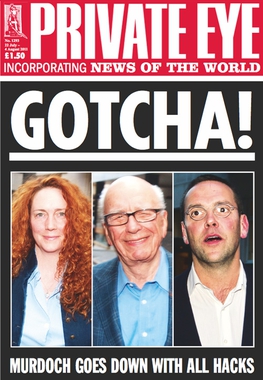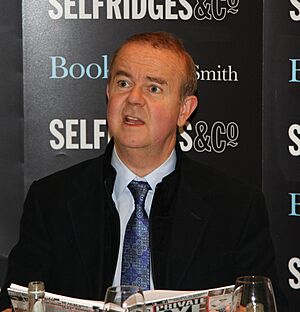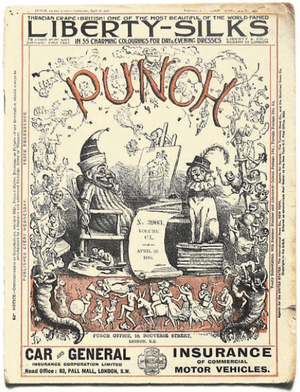Private Eye facts for kids

A July 2011 cover following the closure of the News of the World, making ironic use of a famous 1982 headline from The Sun
|
|
| Editor | Ian Hislop |
|---|---|
| Categories | Satirical news magazine |
| Frequency | Fortnightly |
| Circulation | 233,118 (Jul–Dec 2023) |
| Founded | 1961 |
| Company | Pressdram Ltd |
| Based in | London W1 United Kingdom |
| Language | English |
| ISSN | 0032-888X |
Private Eye is a British magazine that comes out every two weeks. It is known for its funny stories and jokes about current events. The magazine also does deep investigations into important news. It started in 1961 and is published in London. Ian Hislop has been its editor since 1986.
Private Eye is very popular and is the best-selling news magazine in Britain. Many of its inside jokes are now well-known across the UK. Even though many print magazines are selling less, Private Eye is doing very well. It is owned privately and makes a good profit.
The magazine likes to stick to its old ways. It is printed on cheap paper and looks more like a comic book than a serious magazine. Its funny stories and investigations have led to many lawsuits. Many writers use fake names, even a made-up owner called Lord Gnome.
Contents
- History of Private Eye Magazine
- What Makes Private Eye Special?
- Popular Columns in Private Eye
- Special Issues
- Inside Jokes and Secret Meanings
- Cartoons in Private Eye
- Other Cool Things from Private Eye
- Private Eye Online Extras
- Lawsuits Against Private Eye
- Who Owns Private Eye?
- The Private Eye Logo
- See also
History of Private Eye Magazine
The idea for Private Eye came from a school magazine called The Walopian. This magazine was made by students at Shrewsbury School in the 1950s. It made fun of school traditions and teachers. Some of these students, like Richard Ingrams and Paul Foot, later went to Oxford University. There, they met others who would help start Private Eye.
The group learned about a new printing method that made it easy to create a magazine. Andrew Osmond helped fund the first issue, which came out in 1961. He also suggested the name Private Eye.
At first, Christopher Booker edited the magazine, and Willie Rushton designed it. Peter Usborne was the first managing director. Later, Richard Ingrams became the editor. The early magazines were mostly full of jokes, like an extended school newspaper.
In 1962, Peter Cook, who started a comedy club, bought Private Eye. He also wrote for the magazine for a long time. Other important people who helped the magazine grow included Auberon Waugh and Claud Cockburn. Christopher Logue wrote a popular column called "True Stories." This column featured funny clippings from other newspapers.
Richard Ingrams was the editor until 1986. Then, Ian Hislop took over. Ingrams is still the chairman of the company that owns the magazine.
What Makes Private Eye Special?
Private Eye often writes about the mistakes and bad actions of powerful people. Because of this, it has faced many lawsuits for saying things that people claim are untrue. The magazine's supporters say it often shares news that other newspapers are too scared to print.
The magazine also points out errors and unfair actions by other newspapers. This happens in a column called "Street of Shame." This name comes from Fleet Street, where many newspapers used to be. It also covers national politics and local government issues. These local stories are found in the "Rotten Boroughs" column.
The "In the Back" section is where the magazine publishes its long investigations. These often uncover hidden scandals. A financial column called "In the City" looks into money scandals and unfair business practices.
Many people who write for Private Eye are experts in their fields. They often write using funny fake names. For example, "Dr B Ching" writes about railways. Sometimes, writers from other newspapers share stories with Private Eye if their own employers won't publish them.
Private Eye has kept its old-fashioned look. It used to be put together with scissors and glue. Today, it still mostly uses black and white printing. It has a lot of text and less empty space than most modern magazines. The main text uses the Times New Roman font.
Popular Columns in Private Eye
Private Eye often features funny columns that make fun of the current Prime Minister. For example, in the 1980s, Richard Ingrams and John Wells wrote "Dear Bill." These were made-up letters from Denis Thatcher, the Prime Minister's husband, to a friend.
The In The Back section is famous for its investigative journalism. Paul Foot was a well-known journalist who wrote for this section. Private Eye was one of the news groups that looked into the Paradise Papers. These findings were shared in In the Back.
Nooks and Corners is a column that criticizes bad architecture. It was started by John Betjeman in 1971. His daughter, Candida Lycett Green, continued it. For many years, Gavin Stamp wrote it under the name Piloti. This column talks about public buildings and saving Britain's old buildings.
Street of Shame looks at how journalists behave. It covers things like unfair reporting or when owners influence news. This column often gets tips from people in the news business. Ian Hislop talked about this work at the Leveson Inquiry, which looked into press ethics.
The Rotten Boroughs column focuses on problems in local governments. It reports on things like corruption or unfairness in local elections. The name comes from old "rotten boroughs" where only a few people could vote.
The magazine also has many other small, regular sections.
Special Issues
Sometimes, Private Eye publishes special editions. These focus on big events or problems. For example, they covered the government's handling of the 2001 UK foot and mouth crisis. They also wrote about the Lockerbie bombing and the MMR vaccine controversy.
In 2004, a special issue honored Paul Foot after he passed away. In 2005, The Guardian newspaper and Private Eye started the Paul Foot Award. This award gives £10,000 to journalists who do great investigative work.
Inside Jokes and Secret Meanings
Private Eye uses many inside jokes and hidden references. These are often hard to understand unless you have read the magazine for a long time. They also use special words to avoid lawsuits. Some of these terms are no longer used once their secret meanings become too well known.
The magazine often spells names of companies wrong on purpose. For example, "Crapita" for Capita or "The Grauniad" for The Guardian. The latter makes fun of The Guardian's old typos. Some famous people are called by different names. For instance, Piers Morgan is "Piers Moron," and Rupert Murdoch is the "Dirty Digger." Queen Elizabeth II was "Brenda," and King Charles III is "Brian."
The first part of the magazine has news and investigations. It uses these jokes more subtly. The second part is more about funny stories and sharp humor. It uses the jokes more openly.
Cartoons in Private Eye
Private Eye is full of cartoons. It has many one-off drawings and several regular comic strips:
- Apparently by Mike Barfield – makes fun of daily life and popular trends.
- Celeb by Charles Peattie and Mark Warren – about a rock star named Gary Bloke. It started in 1987.
- Desperate Business by Modern Toss – shows funny stereotypes of different jobs.
- EUphemisms by RGJ – features a European Union official saying one thing, but meaning another.
- Fallen Angels – a cartoon about problems in the National Health Service.
- First Drafts by Simon Pearsell – shows the imagined first versions of famous books.
- Forgotten Moments in Music History – has hidden clues about famous songs and singers.
- It's Grim Up North London by Knife and Packer – makes fun of trendy people in Islington. It has been in the magazine since 1999.
- Logos as They Should Be – makes fun of logos from well-known companies.
- The Premiersh*ts by Paul Wood – makes fun of professional football and players in the Premier League.
- Snipcock & Tweed by Nick Newman – about two book publishers.
- Supermodels by Neil Kerber – makes fun of the lives of supermodels.
- Yobs and Yobettes by Tony Husband – makes fun of "yob" culture. It has been in the magazine since the late 1980s.
- Young British Artists by Birch – a spoof of the Young British Artists movement.
Some older cartoon strips from the magazine include:
- The Adventures of Mr Millibean – showed Ed Miliband as Rowan Atkinson's Mr. Bean.
- Barry McKenzie – a popular strip from the 1960s about an Australian living in London. It was written by Barry Humphries.
- Battle for Britain – made fun of British politics like a World War II comic.
- Dave Snooty and his New Pals – looked like The Beano comic. It made fun of David Cameron as "Dave Snooty."
- The Cloggies by Bill Tidy – about clog dancers.
- The Commuters by Grizelda – followed two people trying to catch a train to work.
- Global Warming: The Plus Side – made fun of the effects of global warming.
- The Has-Beano – looked like The Beano. It made fun of The Spectator and Boris Johnson.
- Liz – a cartoon about the Royal Family in the style of Viz comic.
- Meet the Clintstones – The Prehistoric First Family – looked like The Flintstones. It made fun of Bill and Hillary Clinton.
Private Eye has also used drawings from many other artists. These include Ralph Steadman, Gerald Scarfe, and Kathryn Lamb.
Other Cool Things from Private Eye
Over the years, Private Eye has created other things besides the magazine:
- Books: They publish annual collections of cartoons and investigative pamphlets.
- Audio Recordings: They have released recordings.
- Private Eye TV: A TV show based on the magazine that aired on the BBC in 1971.
- Memorabilia: Like Christmas cards and other special items.
Private Eye Online Extras
- Page 94, The Private Eye Podcast: This podcast started in 2015. Its name comes from a running joke in the magazine. It is hosted by Andrew Hunter Murray.
- Eyeplayer: This section has videos and audio since 2008. It includes funny phone calls and live performances.
- Covers Library: You can see all the magazine covers from 1961 to today.
- Councillors Map: An online map that shows local council members who have not paid their taxes.
- UK Tax Haven Map: A map that shows properties in England and Wales owned by companies from other countries.
- The Eye At 50 Blog: A blog that ran from 2009 to 2013.
Lawsuits Against Private Eye
Private Eye is known for facing many lawsuits. Ian Hislop is even listed in the Guinness Book of Records as the person who has been sued the most in English legal history.
The magazine often sets aside money to pay for these lawsuits. However, they also try to solve problems by printing letters from people who are upset. Geoffrey Bindman, a human rights lawyer, represented the magazine for many years.
The first person to successfully sue Private Eye was Colin Watson. He won £750 because the magazine described his writing in a way he didn't like.
On the cover of their tenth-anniversary issue in 1971, the magazine showed a cartoon tombstone. It listed many famous names with the words: "They did not sue in vain." This was a joke about all the people who had sued them.
In 1976, James Goldsmith brought serious charges against the magazine. This meant the editor, Richard Ingrams, could have gone to prison. Goldsmith won part of the case, and they eventually settled. The case almost made Private Eye go bankrupt. Readers helped by donating money to a "Goldenballs Fund."
Robert Maxwell won a large sum of money from the magazine. This was because they suggested he looked like a criminal. Ian Hislop joked about it on the news, saying, "I've just given a fat cheque to a fat Czech."
In 1999, Samuel Yeboah won money and an apology from the magazine. The "Rotten Borough" column had called him corrupt many times.
Private Eye won a case in 2001. A man named John Stuart Condliffe dropped his lawsuit and paid the magazine £100,000 for their legal costs. This was a big win for the magazine.
In 2009, Private Eye successfully fought against an order that tried to stop them from publishing a report. This report was about Michael Napier, a former head of the Law Society. This win helped make other legal rulings more public.
Who Owns Private Eye?
The magazine is owned by a mix of people and a company called Pressdram Ltd. Peter Cook bought this company in 1961.
Private Eye does not usually list its owners or staff. In 1981, a book about the magazine said that Peter Cook owned most of the shares. Other owners included actors Dirk Bogarde and Jane Asher. Many of the original owners have passed away. The shares can only be sold for the price they were first bought.
As of 2021, the shareholders include:
- Jane Asher
- Elizabeth Cook
- The executor of the estate of Lord Faringdon
- Ian Hislop (who is also a director)
- Private Eye (Productions) Ltd
- Anthony Rushton (who is also a director)
- The executor of the estate of Sarah Seymour
- The Private Eye Trust
- Peter Usborne (1937–2023)
- Brock van den Bogaerde (a nephew of Bogarde)
- Sheila Molnar
- Geoff Elwell (who is also the company secretary)
Inside the magazine, the owner is always called "Lord Gnome." This is a funny way to make fun of powerful newspaper owners.
The Private Eye Logo
The magazine's main picture shows a knight in armor named Gnitty. He has a bent sword. This is a funny copy of the "Crusader" logo used by the Daily Express newspaper. During the COVID-19 pandemic, Gnitty was shown wearing a mask.
Matthew Carter designed the text for the magazine's name. He later designed famous computer fonts like Verdana and Georgia. He said that Nicholas Luard, an early co-owner, wanted to make Private Eye a fancy magazine. But Matthew Carter realized this was not a good idea after meeting the original creators.
See also
- The Spectator
- The Onion
- Humour magazine
- List of satirical magazines
- List of satirical news websites



